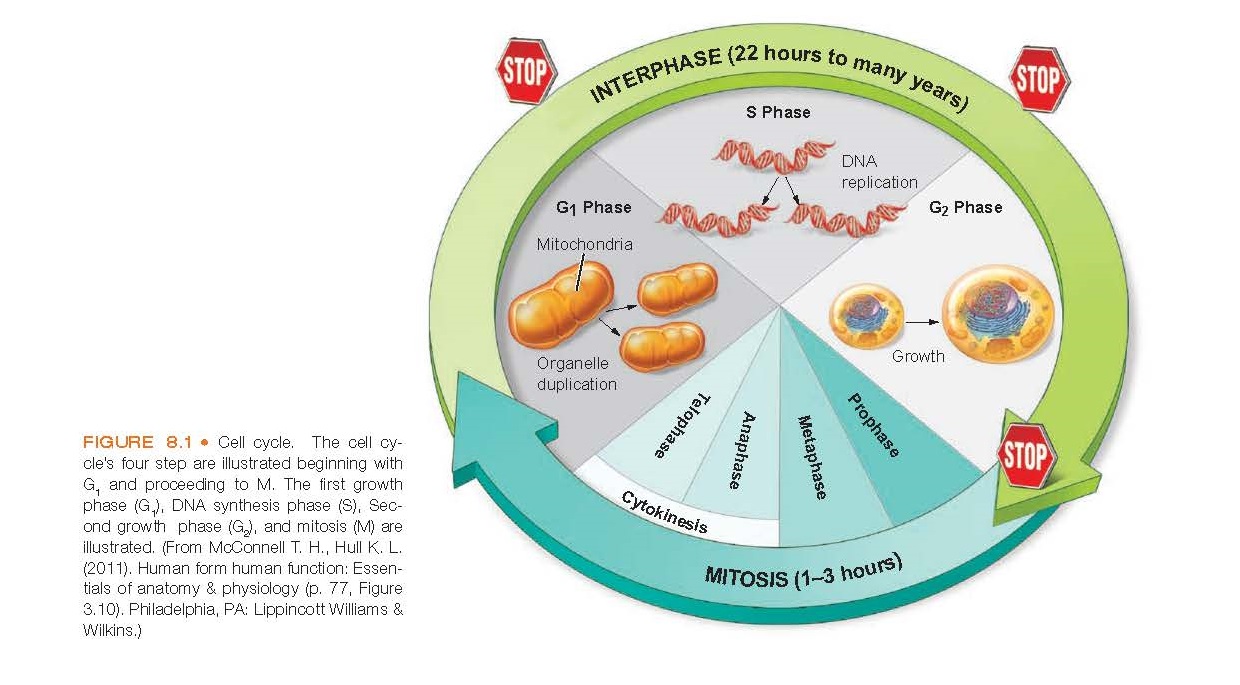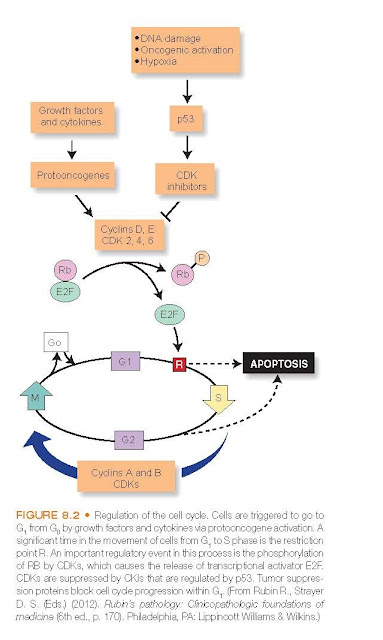Is an orderly sequence
of events that occur as a cell duplicates
its contents and divides (Fig. 8.1). During the cell cycle, genetic information
is duplicated and the duplicated chromosomes are appropriately aligned for distribution
between two genetically identical
daughter cells.
The cell cycle is divided into four
phases, referred to as G1 , S, G2 , and M. G1 (gap 1) occurs after
the postmitosis phase when DNA synthesis
stops and ribonucleic acid (RNA) and protein synthesis and cell growth take place.
During the S phase, DNA synthesis occurs, causing two separate sets of
chromosomes to develop, one for each daughter cell. G2 (gap 2) is the premitotic phase and is similar
to G1 in that DNA synthesis stops,
but RNA and protein synthesis continue. The phases, G1 , S, and G2 are referred to as interphase. The M phase
is the phase of nuclear division,
or mitosis, and cytoplasmic division. Continually dividing cells, such as the skin’s
stratified squamous epithelium, continue to cycle from one mitotic division to the
next. When environmental conditions are adverse, such as nutrient or growth factor
unavailability, or when cells are highly specialized, cells may leave the cell cycle,
becoming mitotically quiescent, and reside in a resting state known as G0 . Cells in G0 may reenter the cell cycle in response to extracellular
nutrients, growth factors, hormones, and other signals such as blood loss or tissue
injury that trigger cell growth. Highly specialized and terminally differentiated
cells, such as neurons, may permanently stay in G0.
Within the cell cycle, pauses can be
made if the specific events of the cell cycle phases have not been completed. For example, mitosis
is prevented until DNA is properly replicated.
In addition, chromosome separation in
mitosis is delayed until all spindle fibers have attached to the chromosomes. These
are opportunities for checking the accuracy of DNA replication. These DNA damage
checkpoints allow for any defects to be identified and repaired, thereby ensuring
that each daughter cell receives a full complement of genetic information, identical
to that of the parent cell.
The cyclins are a group of proteins
that control the entry and progression of cells through the cell cycle. Cyclins
bind to proteins called cyclin-dependent kinases (CDKs). Kinases are
enzymes that phosphorylate proteins. The CDKs phosphorylate specific target proteins
and are expressed continuously during the cell cycle but in an inactive form, whereas
the cyclins are synthesized during specific phases of the cell cycle and then degraded
by ubiquitination once their task is completed. Different arrangements of cyclins
and CDKs are associated with each stage of the cell cycle (Fig. 8.2). For example,
cyclin B and CDK1 control the transition from G2 to M. As the cell moves into G2, cyclin B is synthesized and binds to CDK1. The cyclin B–CDK1 complex then directs the
events leading to mitosis, including DNA replication and assembly of the mitotic
spindle. Although each phase of the
cell cycle is monitored carefully, the transition from G2 to M
is considered to be one of the most important checkpoints in the cell cycle. In
addition to the synthesis and degradation of the cyclins, the cyclin–CDK complexes
are regulated by the binding of CDK inhibitors (CKIs). The CKIs are particularly
important in regulating cell cycle checkpoints during which mistakes in DNA replication
are repaired. Manipulation of cyclins, CDKs, and CKIs is the basis for development
of newer forms of drug therapy that
can be used in cancer treatment.
Synthesis and Mitosis
Synthesis (S) and mitosis (M) represent the two major
phases of the cell cycle. The S phase, which
takes about 10 to 12 hours, is the period of DNA synthesis and replica-
tion of the chromosomes. The M phase,
which usually takes less than an hour, involves formation of the mitotic
spindle cell division with formation of two daughter cells.
Gaps 1 and 2
Because most cells require time to
grow and double their mass of proteins and organelles, extra gaps (G) are
inserted into the cell cycle. G1 is the stage during which the cell is starting to prepare for DNA replication and mitosis through protein
synthesis and an increase in organelle and cytoskeletal elements. G2 is the premitotic phase. During this phase, enzymes and other proteins
needed for cell division are synthesized and moved to their proper sites.
Gap 0
G0 is the stage after mitosis
during which a cell may leave the
cell cycle and either remain in a state of inactivity or reenter the cell cycle
at another time. Labile cells, such as blood cells and
those that line the gastrointestinal tract, do not enter G0 but continue cycling. Stable cells, such as
hepatocytes, enter G0 after mitosis but can reenter the cell cycle
when stimulated by the loss of other
cells. Permanent cells, such as neurons that become terminally differentiated
after mitosis, leave the cell cycle and are no longer capable of cell renewal.
Checkpoints and Cyclins
In most
cells, there are several checkpoints in the cell cycle, at which time the cycle can be arrested if previous
events have not been
completed. For example, the G1/S checkpoint monitors
whether the DNA in the chromosomes is damaged by
radiation or chemicals, and the G2/M checkpoint prevents entry into mitosis if DNA replication is not
complete. The cyclins are a
family of proteins that control entry and
progression of cells through the cell cycle. They function by activating proteins called CDKs. Different
combinations of cyclins and CDKs
are associated with each stage of
the cell
cycle. In addition to the synthesis and degradation of the cyclins, the cyclin–CDK complexes are
regulated by the binding of CKIs.
The CDK inhibitors are particularly important
in regulating cell cycle checkpoints during which mistakes
in DNA replication are repaired.










